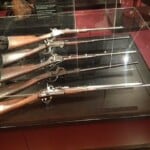
George Custer
Lt Colonel George Armstrong Custer (also formerly a Major General) remains one of the most captivating figures in the annals of American history. His life was inextricably intertwined with the era of the American West, an epoch characterized by the clash of diverse cultures and the rapid development of technology. One of the most notable elements of this period was the evolution of firearms, which played a central role in the narrative of Custer’s life and death.
Colonel Custer and His Firearms
A West Point graduate and cavalry commander in the Union Army during the Civil War, Custer was well-acquainted with the weapons of his era. The most common firearm in use by the Union Army during the Civil War was the Springfield Model 1861 rifle, a muzzle-loading percussion cap rifle. Custer, however, as a cavalry officer, would have most likely carried a sidearm for personal defense and a carbine for combat, both typically of .44 or .45 caliber.
The Remington New Model Army Revolver was a popular sidearm of the time. Made with advancements in manufacturing processes that allowed for interchangeable parts, it was reliable and robust. Another favored firearm was the Colt Single Action Army Revolver, often called "the Peacemaker". This six-shot revolver was renowned for its balance, power, and reliability.
In terms of long guns, Custer was known to have favored the Spencer carbine, a lever-action rifle that was one of the first to use metallic cartridges. He famously used a pair of Spencers at the Battle of Washita River in 1868. Its seven-round magazine offered a relatively high rate of fire, which made it a preferred choice among cavalry officers.
The Firearms of His Adversaries
The firearms used by the Native American tribes Custer encountered varied widely. Many used traditional weapons such as bows and arrows or war clubs, but by the mid to late 19th century, many Native American warriors had also acquired firearms through trade or as battlefield pick-ups.
The tribes Custer faced at the Battle of Little Bighorn in 1876, primarily the Lakota Sioux and Cheyenne, had a variety of firearms. These ranged from older muzzle-loading rifles and smoothbore muskets to more modern breech-loading and repeating rifles. One such weapon was the Springfield Model 1873, ironically also known as "the Trapdoor Springfield," which was the standard issue rifle for the U.S. Army at the time. There were also a number of Henry and Winchester repeating rifles—highly effective weapons that could fire multiple rounds before needing to be reloaded.
While a broad variety of firearms were used by Native American tribes during this period, including muzzle-loading and breech-loading rifles, there were indeed lever-action repeating rifles among their arsenal. These weapons, such as the Henry and Winchester repeaters, represented a significant advancement in technology and offered a major tactical advantage in combat.
Repeating rifles allowed for multiple shots to be fired before reloading was necessary. The Henry rifle, for instance, had a magazine capacity of 15 rounds. Similarly, various models of Winchester rifles, including the iconic Winchester Model 1873, had a magazine capacity of around 10-15 rounds depending on the model and caliber.
Such repeating rifles in the hands of the Lakota Sioux and Cheyenne warriors at the Battle of Little Bighorn in 1876 contributed significantly to the overwhelming firepower that defeated Custer and his troops. The high rate of fire these weapons offered likely played a crucial role in the battle, contributing to the devastating defeat of the 7th Cavalry.
Custer's Relationship with Firearms
Custer’s relationship with firearms was both professional and personal. Professionally, as a cavalry officer, he understood the importance of firepower and its use in tactics and strategy. His success at the Battle of Washita River was, in part, due to his effective use of the firepower provided by the Spencer carbines.
Personally, Custer was known to have an appreciation for well-made firearms. There are records of him ordering custom engraved weapons, a sign of prestige and personal style during the period. It is also worth noting that Custer, like many soldiers of his time, probably had a practical understanding of firearm maintenance—an essential skill in an era when a misfire could easily prove fatal.
Conclusion
Colonel Custer’s life and death were closely tied to the firearms of his era. From the standard military issue weapons of the Union Army, to the diverse assortment of firearms used by the Native American tribes he fought against, these weapons shaped the course of his career. The technologies embodied in these firearms, from simple muzzle-loaders to advanced repeaters, mirror the broader story of a nation
in rapid transition. Custer himself, a figure of legend and controversy, stands as a symbol of this transformative period in American history.
One of the best books on Custer:

If you know of any forums or sites that should be referenced on this listing, please let us know here.



